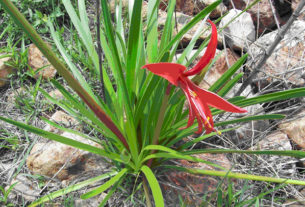Although Cinco de Mayo, the national May 5th holiday commemorating the 1862 Battle of Puebla, is celebrated with much more fervor by Mexicans living in the United States than in Mexico, one exception is the state of Puebla, and especially the city of Puebla itself. Here — in the colonial city where mole poblana originated — the poblanos stage a grand parade every year, followed by a reenactment of the battle on the field where it took place. That the ill-equipped and outnumbered Mexicans defeated what was then the most powerful army in the world, that of Napoleon III of France, is a source of great nationalistic pride and self-esteem.
The celebration, like any other in Mexico, is accompanied by plenty of food: in this case, the regional chalupas and molotes. Always present at the feast is mole poblano, considered to be the national dish of Mexico.
Although we only tackled the parade crowd a couple of times in our years of living in Puebla, we did attend local and neighborhood parties which, like many fiestas all over the country, featured mole as the main attraction. Cinco de Mayo, therefore, seems as good a time as any to delve into the origins and definitions of the culinary term “mole.”
Mole (pronounced MOH- lay) is probably the most talked-about but least understood of Mexico’s regional dishes. This is because the term is more general than most people, including culinary experts outside of Mexico, believe it to be. While mole poblano de guajalote – Puebla-style turkey mole — is considered the national dish, it is by no means the only mole. One popular (non-Mexican) food writer defines mole as a “thick, dark sauce” when, in fact, it is often neither dark nor particularly thick. Mole can be anything from dark and thick to soup-like and bright green, with red, yellow and black moles each claiming aficionados in different regions.
Although the word mole comes from the Nahuatl mulli, meaning sauce or potage, it has been pointed out by culinary anthropologists that very few of the ingredients in mole poblano were indigenous to the New World. The native chiles and chocolate, as well as the turkey itself, were indispensable in creating the dish, but almost all the spices were Old World ingredients. In contrast, nearly all the seasonings in Oaxaca’s green mole are herbs native to the region.
In their attempts to characterize mole poblano as a culinary symbol of Mexico’s mestizaje — the racial mixing of the indigenous people and the Europeans — authors have produced several legends concerning its origin. The most widely accepted of these has Sor Andrea de la Asuncion, of the Convent of Santa Rosa in Puebla, creating it for the visit of the archbishop, sometime during the 1680s. Another version involves a Fray Pascual, who supposedly knocked over a tray of spices into the cazuela in which dinner was being prepared, accidentally coming up with a mouth-watering creation.
Since the first published recipes for mole did not appear until over a century later, after the War of Independence from Spain, the true origin of mole poblano will probably never be clear. As a general term, however, the Nahuatl word meaning simply a “sauce” is probably the only one that truly defines mole.
The two states best known for moles are Puebla and Oaxaca, though other areas have regional dishes known as moles. Since Mexico’s ethnic groups, with their various culinary traditions, do not necessarily conform to political boundaries, many different moles may appear in the same state. Mexican geography, with its long mountain ranges, also plays a part in these variations. Oaxaca, for example, known as The Land of the Seven Moles, is so broken up by mountains that even within the same state there are several different microclimates and culinary regions. Moles here vary from the thick, nearly black mole negro to the fresh, bright green, herb-infused mole verde. Manchamanteles, the southern Mexican chicken and fruit stew, is considered by the oaxaqueños to be one of the seven moles of Oaxaca, though poblanos insist that it originated in Puebla. (When both of these states claim a certain dish, it may have originated with the most northern of the Mixteca people, who inhabit the mixteca poblana region, encompassing what is now southern Puebla and northern Oaxaca.)
While many of the moles cannot be made from pre-ground pastes, a few, such as mole poblano and the negro and colorado versions of Oaxaca, are available in this form. Preparing mole from a commercial paste involves first dissolving it in a well-oiled cazuela or heavy-bottomed pot, adding broth a little at a time, stirring constantly to prevent sticking, until a smooth consistency is obtained. A good, tasty homemade stock is essential, the most common being turkey or chicken, though some moles are delicious with pork. Follow the directions for at least a quarter kilo (about a half pound) of mole paste, because leftover sauce is excellent for enchiladas and as a filling for tamales, and freezes well.
As good as some of the pastes can be, many moles must be made from scratch, a very rewarding experience, and especially fun to do with a friend or two. The last-minute addition of the fresh herbs to a mole verde, for example, is a heady experience and one that could not be enjoyed by merely diluting a paste. Below are some mole recipes to try at home, whether celebrating Cinco de Mayo, a family occasion, or the company of good friends.
- Puebla-style turkey mole: Mole poblano de guajalote
- Oaxacan yellow mole: Amarillo
- Chicken in green mole sauce: Pollo en mole verde
- Herbed green mole: Mole verde con hierbas
- Turkey in a dark spice sauce: Chilmole
- Oaxacan black mole: Mole negro de Oaxaca
- Chicken and fruit stew: Manchamanteles:
- Amaranth mole: Pollo en amaranto

